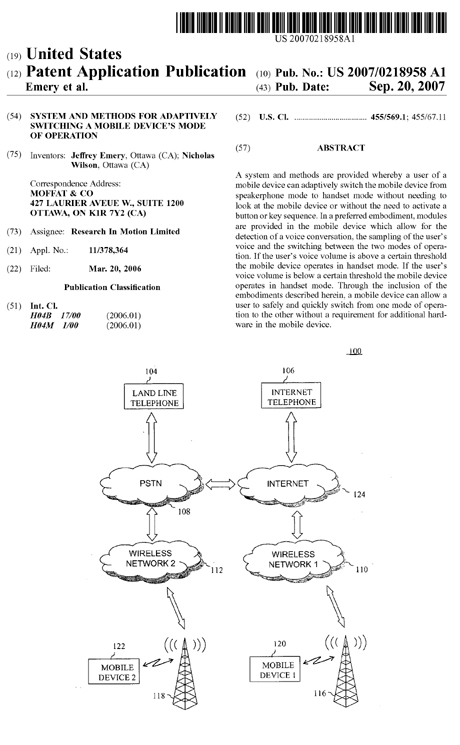BlackBerry Patent app would automate switching between Speaker and Handset mode

A BlackBerry Patent application just published this morning describes technology that would enable switching from handset mode to speaker mode without pushing a button on a BlackBerry device.
The application is entitled, System and methods for adaptively switching a mobile device's mode of operation.
As in the case of many other BlackBerry Patent applications, the Abstract provides a useful overview of what is being proposed.
The Abstract reads:
A system and methods are provided whereby a user of a mobile device can adaptively switch the mobile device from speakerphone mode to handset mode without needing to look at the mobile device or without the need to activate a button or key sequence.
In a preferred embodiment, modules are provided in the mobile device which allow for the detection of a voice conversation, the sampling of the user's voice and the switching between the two modes of operation.
If the user's voice volume is above a certain threshold the mobile device operates in handset mode. If the user's voice volume is below a certain threshold the mobile device operates in handset mode.
Through the inclusion of the embodiments described herein, a mobile device can allow a user to safely and quickly switch from one mode of operation to the other without a requirement for additional hardware in the mobile device.
For an understanding of how this works, lets go to the Application and jump to Figure 3 and its explanatory text.
FIG. 3 is a block diagram showing an exemplary method in accordance with a preferred embodiment.
The method begins at step 300 where a voice conversation is detected at mobile device 122. In step 305 a sample of the user's voice is taken, preferably by measuring the level of volume detected by microphone 236. Step 305 will filter out undesirable samples as described in the description of sampling module 262 above.
In step 310, a determination is made as to whether the sample taken in step 305 is different from a previous sample taken in a previous iteration of step 305. Step 310 determines that a sample is different if the sample is on the other side of the threshold from a previous sample, or if this is the first sample taken at step 305 during the voice conversation detected in step 300.
If step 310 determines that the sample taken in step 305 is not different, the method returns to step 305 to take another sample. A suitable delay is used between repeated executions of step 305, 0.5 seconds or 1 second for example. If step 310 determines that the sample taken in step 305 is different, the method moves to step 315 where a determination is made as to whether the sample from step 305 is above or below the threshold.
If the sample is above the threshold, step 320 activates handset mode at mobile device 122. If the sample is below the threshold, step 325 activates speakerphone mode at mobile device 122. After execution of step 320 or 325, the method returns to step 305 where another sample of the user's voice will be taken after a short delay. Through the execution of this method, mobile device 122 is able to adaptively operate in the mode of operation which is consistent with the user's current desired mode of operation.
In another preferred embodiment, step 305 will acquire multiple samples of the user's voice during a consecutive period of time, 3 samples in 1.5 seconds for example. Step 310 will evaluate the samples to determine the trend in the user's voice.
Continuing with the example of step 305 providing 3 samples in 1.5 seconds and where mobile device 122 is currently operating in speakerphone mode:
If the first sample is above the threshold, the second sample is below the threshold and the third sample is above the threshold step 310 will determine that, based on the trend of the three samples, the user's voice is on a different side of the thresholds. Continuing with this example, step 315 will determine that the average of the three samples is above the threshold and step 320 will activate handset mode.
It is to be understood that other configurations of the method described by FIG. 3 are possible. For example, step 310 could be removed from the method, step 305 would provide a sample directly to step 315 which would make the determination as to whether the sample is above or below the threshold. As another example, step 305 could acquire 2 samples in 1 second or 4 samples in 1 second.
Hey, I am all for this. The fewer times I have to press BlackBerry buttons during a voice conversation, the better.
